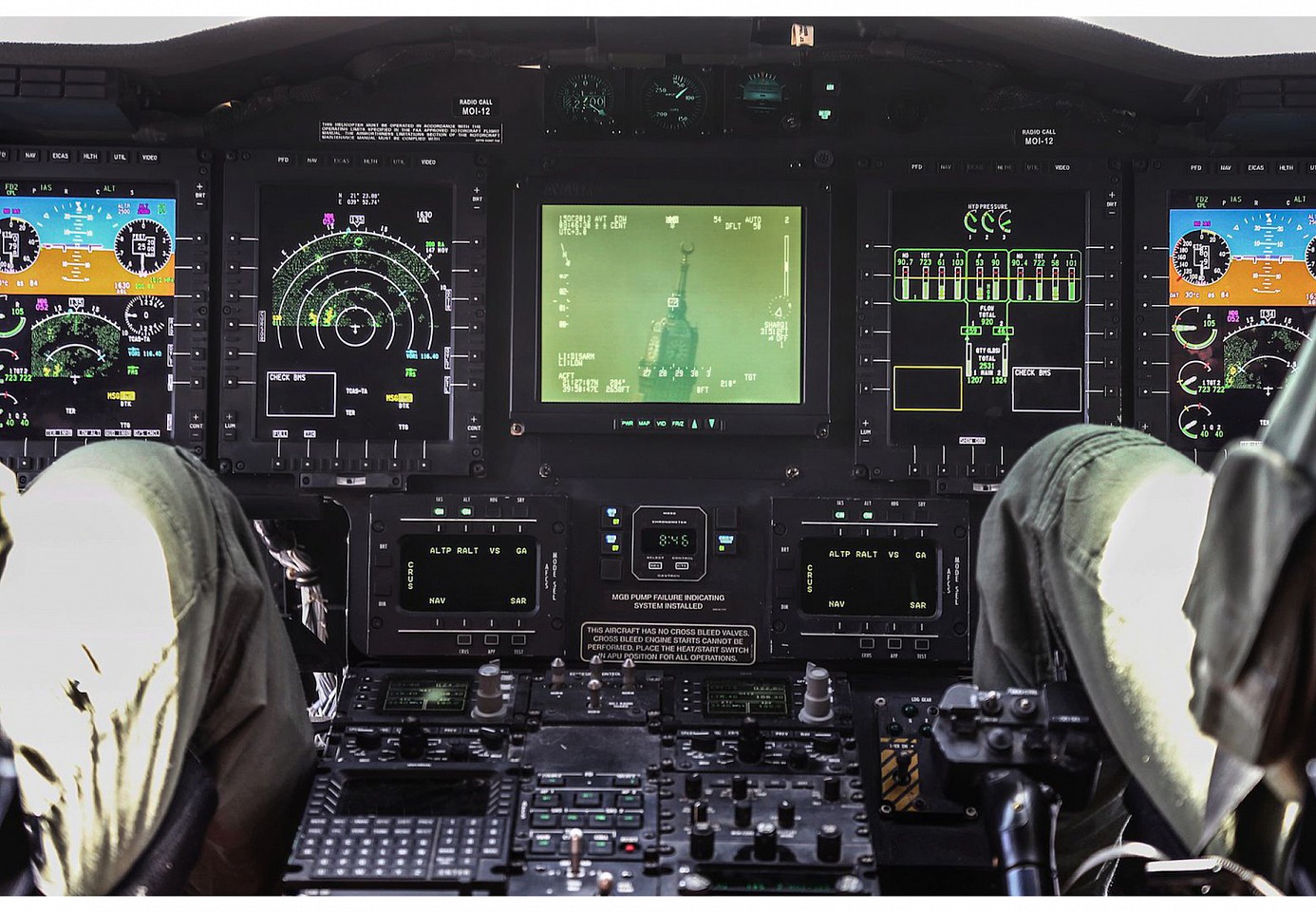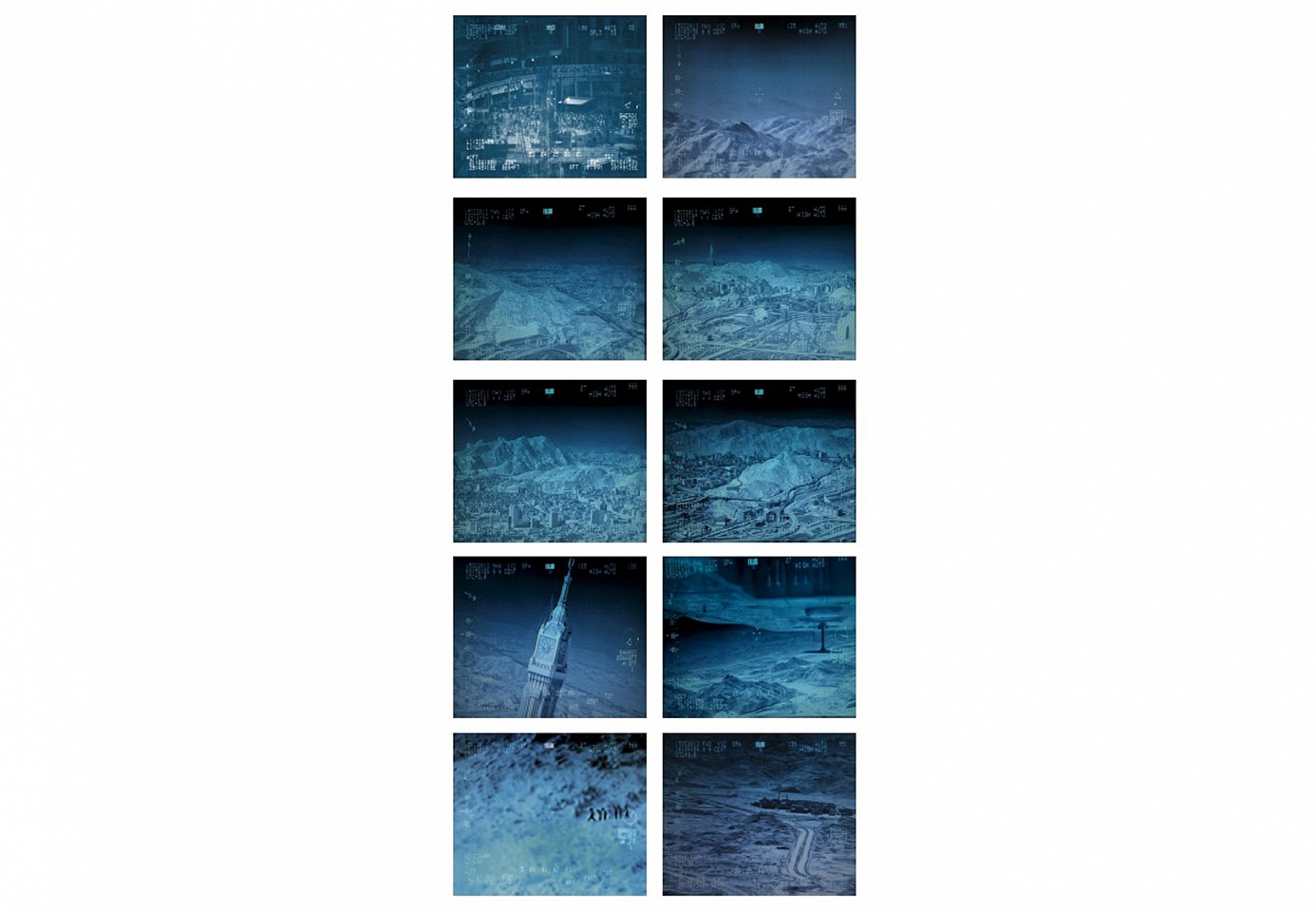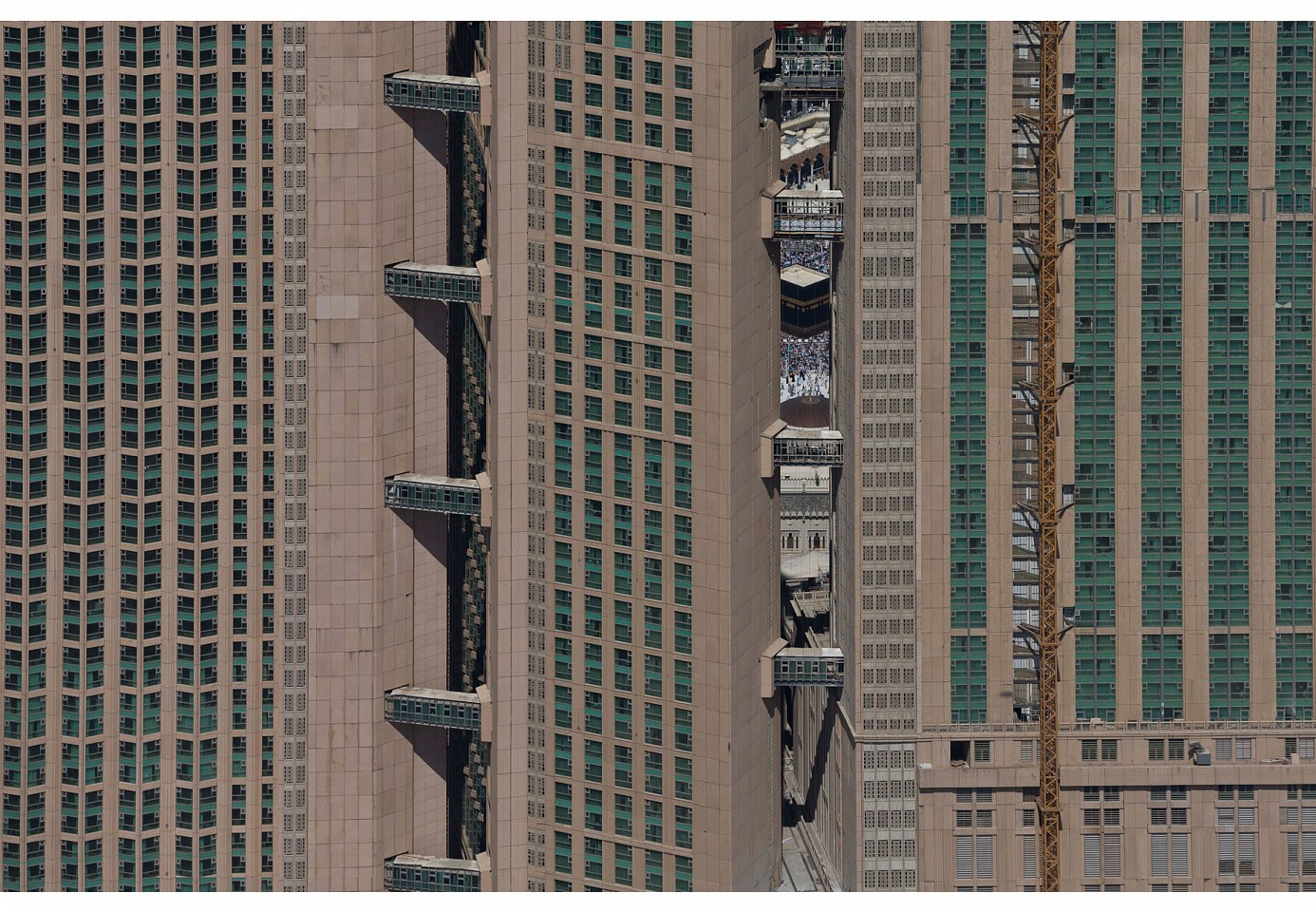Ahmed Mater
Disarm 01, 2013
Fineart Latex printer and matt 200g unbleached printing paper
140 x 200 cm (55 1/16 x 78 11/16 in.)
Edition of 5 + 1 AP, From Desert of Pharan series
AHM0179
Ahmed Mater
Disarm 02, 2013
Fineart Latex printer and matt 200g unbleached printing paper
140 x 200 cm (55 1/16 x 78 11/16 in.)
Edition of 5 + 1 AP, From Desert of Pharan series
AHM0184
Ahmed Mater
Disarm, 2013
10 LED light boxes
31 x 37 cm (12 3/16 x 14 9/16 in.)
Edition of 5 + 1 AP, From Desert of Pharan series
AHM0189
Ahmed Mater
Abraaj Al Bait Tower, 2012
Laserchrome print on KODAK real photopaper
140 x 200 cm (55 1/8 x 78 3/4 in.)
Edition of 5; From Desert of Pharan series
AHM0023




The lifeline of history is like the lifeline of a river – there is one central artery and thousands of other tributaries, some as thin as hair, branching every which way. The stories of history, like the stories borne by rivers, run as much in the central gushing aorta as in the branching veins, but the official records of history, the narratives that are passed on to posterity, often record only the primary narrative and gloss over the others. Sometimes, the artist has to step in as an alternative historian, and fill up these cracks in truth, cementing the fissures with missing links and pieces, and taking on roles as varied as scribe, chronicler, documentarian or the collective conscience of a people in a certain time and place.
At this point in time, Saudi Arabia is a node of such rapid change that it often baffles comprehension. A taste for secrecy and for avoiding its own truths often frustrates even the best-hearted attempts at documentation. Any man who leaps into the fray to challenge or truthfully complement the overlooked pockets of truth must be credited with courage. In ‘Artificial light’, the artist documents what he calls ‘an unofficial history of the urbanization of Makkah’. While Makkah’s shape, its scope and future change beyond recognition in a central sphere of development where the old and new symbol (the Kaa’ba and the Makkah Clock Tower’) confront each other directly, the shockwaves from this heated centre of conflict spread well into the fringes, into the houses, hearts and minds of the millions that absorb and live this irreversible change from the inside out. The transformation of Makkah is mapped upon their hearts and minds, their daily thoughts, in the way they have thought and will continue to think about their lives, in the way they evaluate and assess their past and in the way they project and plan their future. Their destinies and those of the city are inseparable. In this project, among other things, the artist takes it upon himself to collect these tertiary narratives in the form of audio and video documentaries. For the half-blind of the world, who will not seek beyond the truth of a google search, the narrative of the urbanization of Makkah is a narrative of concrete, but for the spiritually awake and the morally courageous, any narrative of change and transformation is read through stories of humans, not through the weight of concrete and the height of towers. It always has and perhaps, always will be, the moral responsibility of the artist to resurrect the human underbelly of this narrative of concrete and keep it from being buried under the rubble and forgotten from memory.
In the mind of the world, Makkah is a symbol more than a city, and like all symbols, an image of Makkah is not just an image. It is an image which is always read and interpreted by believers and non-believers alike. Layers of meaning, homage, veneration, significance, and history have been kneaded, over timeless decades, into what is a continuous visual narrative – the real or imagined story behind the image, the surcharge of symbolism it has accumulated over the years, and the feelings it evokes in the beholder. Makkah has never been seen neutrally, it has always bathed in its own sacred halo. It has always been seen from a standpoint of emotional and religious fervor, and the visual narrative available to us uptil now has always confirmed the vantage-point of Kaaba in this tale. Kaaba has dominated the visual narrative of Makkah (indeed, the two are almost synonymous to many) - humbly, but regally owning its position as a source, as a self-assured but unassuming quiet black monarch.
The sequence of stills in ‘Artificial Light’ is the latest addition to this narrative. Instead of taking it forward along the older axis of Kaaba’s sanctity and predominance as a sacred symbol, it completely inverts the narrative - a more glamorous, gaudily clad monarch now holds court in the central arena. The trivialization of the Kaaba is, before anything, a physical jolt, an uprooting of a familiar point of focus for the vision. The actors in this new chapter are automatons, electronic limbs of giant-sized machines, superimposing construction grids, and contractual labourers, and the sovereign is, the pictures seem to suggest, the new high rise, doubtless an ode to man’s will to compete and command. As our familiar associations with the Kaaba are shattered, we become alienated from the meaning of Kaaba. We see a Kaaba looking almost done in by the menacing limbs of construction machines, no longer secure about being the natural or only focus. Other pictures are taken from sly perspectives that posit the Kaaba within more consumerist and materialist contexts, forcing us to rethink and re-evaluate its meaning, replacing the comfortable full-stops in our mind with question marks.
The truth is that for Saudi Arabia and Saudis, Makkah is not an extraneous symbol separate from themselves, it is a part of their national and individual ethos. It is the existential denominator of their being and existence. How will the revamped Makkah affect their sense of self and worth? Will it make them disoriented? How culturally appropriate is the glamorous new tower? For the Saudis, is it a broche or an eyesore? To what extent can they identify with it? Does it repel them or are they indifferent to it?
The questions are endless. They all must be answered, but first, they must be faced. In times of change like the ones we live in, art ceases to mean beauty, it means tact, nerve, and the courage to grapple with winds of change. The artist, in these times, is a shower of mirrors. Sometimes, art could simply mean arranging mirrors in such a manner that different views of the same reality face us wherever we turn, and the full picture of truth is sealed from different angles, so that we are trapped with the most burning questions of our beings and surroundings with no way to escape. The changing face of our present is a burning question, for our future depends on it.
-Naima Rashid
Athr Gallery will be exhibiting new work by renowned and celebrated Saudi artist, Ahmed Mater, from his series Desert of Pharan, titled Disarm at Art Basel Hong Kong.
Makkah is a source. Makkah is shaped by its own narrative which can be traced back to the time of Abraham but it also releases increasingly significant effects beyond its borders, as global Muslim populations rise and become more connected. In the city of Makkah a new future is being plotted and planned. The contours of that future becoming visible amidst a landscape teeming with initiatives to develop and reinvent seemingly immutable rituals, states, and assumptions, culminating perhaps, in the re-imagining of life at the centre of the Islamic world. Amid a rapidly changing economic landscape, Makkah is re-examining its methods and its relationships with itself and with the rest of the world. Existing models of urban development have been implemented on a vast scale and equipped with imported financial and development know-how. Makkah is attempting a transformation in order to adapt to the geopolitical, technological, environmental, geomorphological and financial context in which it exists.
In early 2012, Ahmed Mater began a series of deliberately experimental and meandering journeys within this most visited yet most exclusive of sites. In many ways these expeditions—by foot, by car, rarely covering the same route twice and at all times open to creative happenstance—have their roots in psycho-geography, the conceptualization of rudderless urban motion as a form of self-expression that began in post-war Paris and took as its starting point Walter Benjamin’s fascination with the poetic, flâneur-like wanderings of Baudelaire. On the other hand, they refer back to the work of Makkah’s first photographer, the 19th century ‘Makkan doctor’ ‘Abd al-Ghaffar—as a practising doctor himself Mater feels an implicit affinity to him and his work— yet his explorations also go beyond what is usually implied by psycho-geography in terms of their relational dynamic. Mater’s emphasis is on his own progress as well as the social evolution of the people around him, a subject that has acquired added significance in recent years.
Like few cities on earth, Makkah bristles under the weight of its own dramatic symbolism. It is a hallowed site revered by millions and at the same time a point of perpetual immigration. This has been the case for centuries, yet over the last few years the city has begun to be recast, reworked and ultimately reconfigured. With this comes a new set of concerns. There is a dissonance today among many of those who live in the city or maintain an emotional stake in its future regarding what this place is, what it could be or what it should be, all of which provides a contextual background to Mater’s urban exploration.
The Disarm extract of his overarching Desert of Pharan project, shown here at Art Basel Hong Kong, is a collation of photographs and video stills taken by the artist when on shoot from a KSA army helicopter.
Details such as the easily unnoticed ‘disarm’ status on the monitor; the Makkah Royal Clock Tower towering over the Kabbah in the distance; the crowds of pilgrims glimpsed through the tunnels of the new high rise accommodation become latent references to the world’s past and current social and political tensions. Captured in the light box stills, taken from the artist’s unauthorized filming of the monitor, is a hint to Makkah’s plausible future. Here we see a sprawling metropolis monitored from the skies, with an army whose mission it is to detect the undesired movement of illegal pilgrims navigating their way across the arid and inhospitable terrain of the Kabbah Mountains.
MA – I see the tower at 9 o’clock
ZJ – Try to get it to 12 o’clock
MA – OK, tower now at 12
ZJ – Can you see that?
MA – Yes, head straight, it’s incredible
ZJ – I can see the clock hands moving right in front of me
MA – Amazing, we could almost touch the swords and date tree
ZJ – Allahu Akbar
MA – It's too close now
ZJ – Keep your altitude, turn away, move towards 3 o’clock
MA – Time now 8 hundred hours, 46 minutes
ZJ – Exactly
MA – Allahu Akbar Allahkbar
BASE – MI2 movement on F2 Arafat, head to F2, over
ZJ – OK sir, making way to F2 Arafat, over
Disarm – a conversation between two helicopter pilots, extract from 100 Found Objects, 2014, Ahmed Mater.







